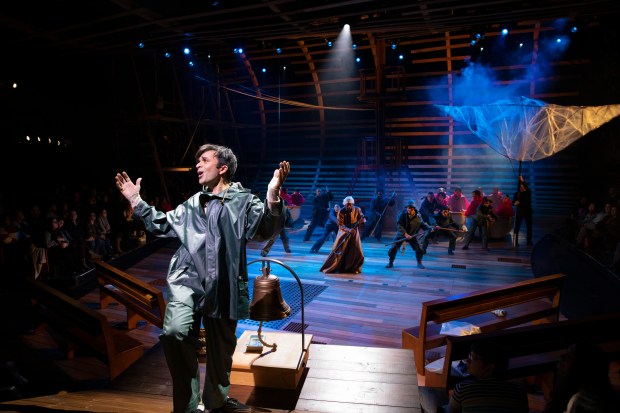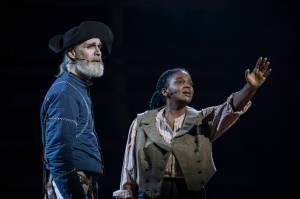ART’s ‘Moby Dick’: Will the Pequod sail again?
CAMBRIDGE – “Thar she blows!”
Whales are not seen in Cambridge, which sits astride a river and not the ocean, but perhaps the most storied and legendary whale hunt in history – three years and 20,000 miles worth — is going on nightly at the Loeb Drama Center.
With his new musical adaptation of “Moby Dick,” writer/composer/actor/orchestrator Dave Malloy has returned to the American Repertory Theater for the fifth time, bringing along with him many members of the team that crafted the ART’s 2015 production of “Natasha, Pierre and the Great Comet of 1812” that transferred to Broadway, earning 12 Tony nominations
Also on board again is director Rachel Chevkin, who helmed “The Great Comet” and was the 2019 Tony Award winner for Best Direction of a Musical for “Hadestown,” and who helped Malloy develop “Moby Dick.”
Together, they have refashioned the storied 1851 Herman Melville novel into a multi-layered “musical reckoning” and have made it – as they did with :The Great Comet” – an immersive experience, with theater-goers seated at the very edge of the huge stage and later being recruited to hunt down whales and help turn the whale sperm into the precious oil.
During the number “Stubbs Kills a Whale,”, the crew and the “volunteers” set off in whaleboats to capture the thrill of the hunt and the capture of the whale in its chaotic glory.
There’s something for everyone here, especially when Malloy ventures forth from Melville’s text to connect with the audience in a different form or fashion.
No one really wants 210 minutes of unmitigated darkness and dirge during the holiday season, and Malloy offers what amounts to an expletive-laden stand-up monologue delivered by Eric Berryman as the prophetic harpooner Fedallah. Berryman drops his costume, knocks down the fourth wall and riffs on several topics, including just what Molly and Chevkin were trying to prove by casting the show the way they did.
Malloy was making a statement in his script when he mandated that “the only white man on the Pequod will be Ahab” and that the crew of The Pequod will be reworked to reflect the length and breadth of the modern American experience, much like recent reworkings of musicals such as “1776.” have done. Ahab is Tom Nelis (Norton Award as Prospero in “The Tempest”) with a tricorn hat and white beard, who commands the stage, a biblical creature to be sure, the tormented one-legged captain who will not rest while the whale lives.
As his first mate, Mr. Starbuck (Starr Busby) must make his way between loyalty to the captain and concern for the welfare of the entire crew as Ahab one by one discards the values and duties of his leadership and surrenders to his obsession with the great white whale.
The uniformly strong crew members of the Pequod also include the harpooner Queequeg (Andrew Cristi), whose bonding with Ishmael is poignant; Matt Kizer as Tasthego; Kalyn West as Stubb; J.D. Mollison as Daggoo; and Anna Ishida as Flask.
There are four distinct parts to “Moby Dick.” In the prologue, we are first introduced to Father Mapple (Dawn L. Troupe), replete in hoop skirt and pirate hat, who addresses us from the Pequod’s crow’s nest on the biblical tale of Jacob and the whale, later to return most effectively as Captain Gardiner of the Rachel, whose child has been carried away by the whale. She fruitlessly begs for Ahab’s help in finding the lad.
We will also meet for the first time Manik Choksi, who in the prologue is actually a troubled young man of the present day who confides in us that it has been a rough couple of years, including a personal loss. The paperback “Moby Dick” he holds in his hand has been a therapeutic escape for him from those problems.
He tells us that he will cast the Pequod’s crew as “The American I want to see.” Then come the fateful words “Call me Ishmael” and we are off on the journey covering 20,000 miles and three years at sea.
For a show 31/2 hours in length, with a 15-minute intermission, “Moby Dick” generally proceeds at a brisk pace. One exception is a lengthy number where Malloy has broken out the story of Pip (Morgan Siobhan Green), the 9-year-old cabin boy who loved to play the tambourine; the point made about the first of the innocent souls to lose their lives in Ahab’s rush to self-destruction almost gets lost as the jazz-influenced number goes on and on.
Set designer Mimi Lien, who won the Tony Award for her work on “The Great Comet,” has crafted a stunning, breathtaking, epochal set for an epic production with the long wooden ribs of the Pequod, the fictional 19th Century Nantucket whaling ship, reaching up and over the audience in the Loeb Drama Center, complete with a crow’s nest, the entire set consisting of wood and ropes.
It captures the expanse of the ocean and the majesty of the great whaling ship. A bank of strong back lights is one of the features of lighting designer Bradley King, another Tony-winning veteran of “The Great Comet.” The sounds of the sea and songs of the whales are represented in the evocative sound design by Hidenori Nakajo. Rachel Padula-Shufelt’s hair, wig and make-up design bring the characters to vivid life, and the costume design by Brenda Abbandanolo ranges from Ishmael’s modern dress to colorful raincoats to the rugged clothing of the whalers..
Eric F. Avery crafted puppets and other objects in the show from waste stream materials as another way to connect the Melville novel to present day issues.
Malloy didn’t shy away from any aspect of the story in crafting his score. He even wrote songs – perhaps for the first time in musical theater history — about the cutting up of the whale (“The Whale as a Dish/Cutting in”) and squeezing the whale sperm until it becomes the precious oil (“A Squeeze of the Hand”).
They are all winningly performed by a fabulous 9-piece perched on the upper reaches of the set.
If Mallory’s opus maximum has piqued your interest, you might want to continue your reacquaintance with the tale with the annual live reading of “Moby Dick,” which will be held at the New Bedford Whaling Museum – there may be no finer place in the country to learn about whaling – from Jan. 3-5, 2020.
It draws readers and enthusiasts from around the globe to the museum’s campus and to the livestream reading online.
The elephant – or in this case, the whale – in the room is where does this show, as wonderful as it may be in many ways, go from here? A lot of money, time and effort has been spent on this production and its great artists, but this is hardly a show that could be easily staged elsewhere without sinking that ship.
It is a spectacular, impressive achievement, but will the Pequod sail again?
The American Repertory Theater production of “Moby Dick.” Music, lyrics, book and orchestration by Dave Malloy. Based on the novel by Herman Melville. Developed and directed by Rachel Chevkin. Choreography by Chanel Silva. At the Loeb Drama Center through Jan. 12. AmericanrepertoryTheater.org.


